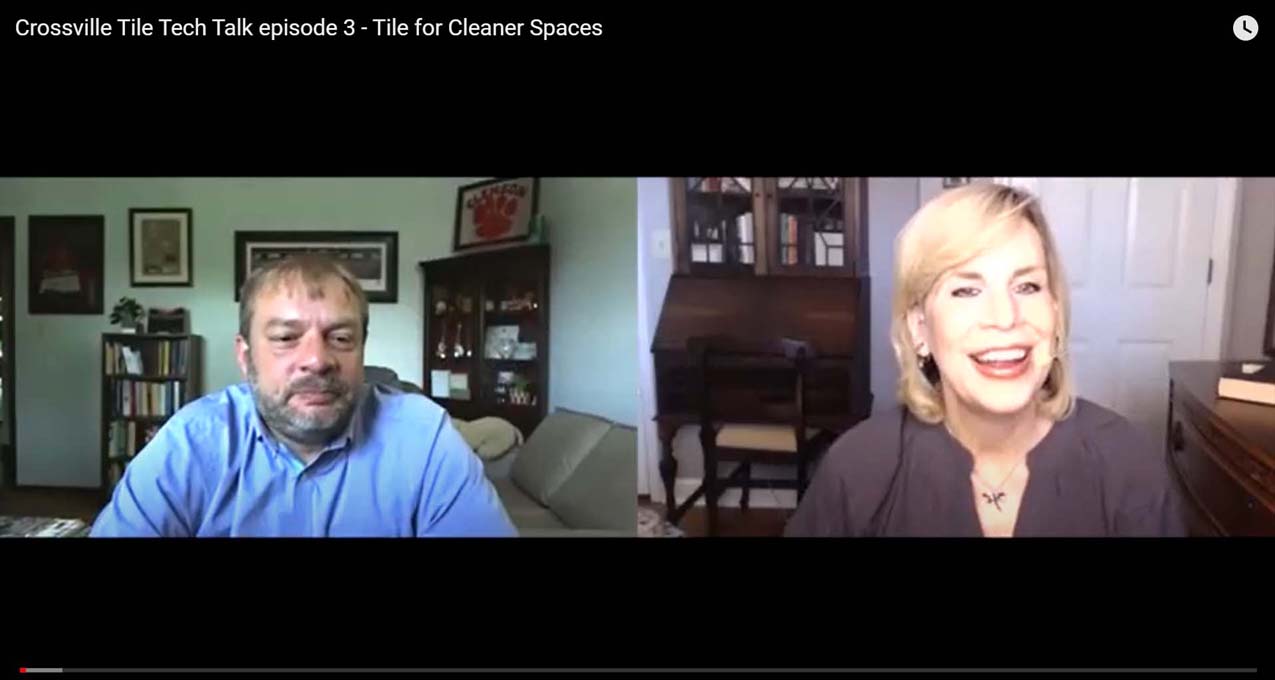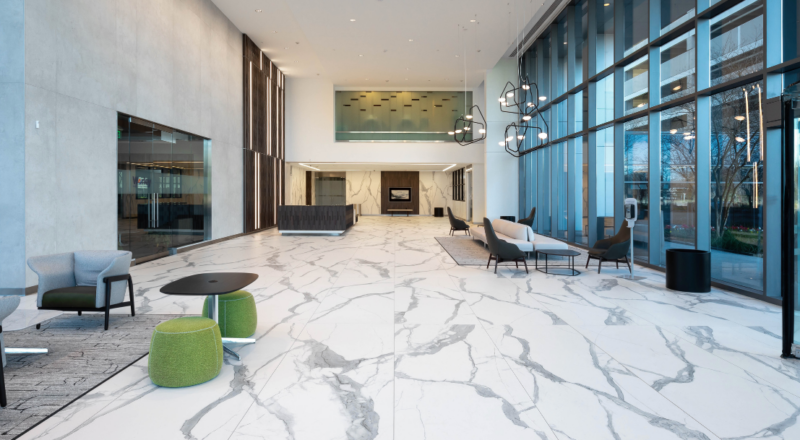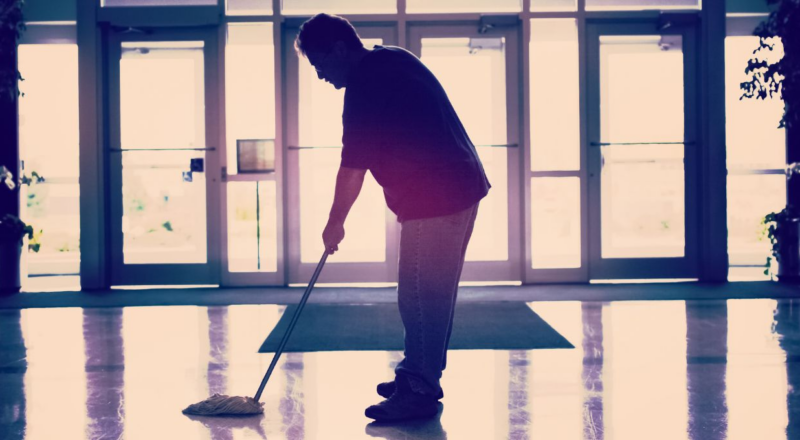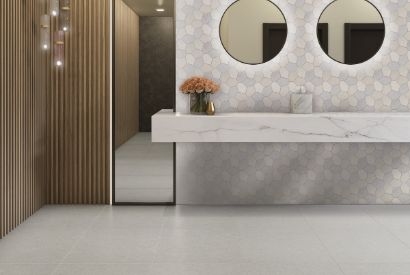In a recent blog post, we highlight a wide range of tile’s advantages for those who are seeking to keep interior spaces cleaner and more hygienic. (Revisit these key points by clicking here.)
Now, we’re taking the discussion further by getting the perspective of our own Noah Chitty. As our technical services director and a leading voice in the tile industry, Noah has lots to share about this important, prevalent topic. View the Crossville Tile Tech Talk interview with Noah and read the full transcript below.
Here are links to articles mentioned or used as reference in Noah’s interview.
 https://whytile.com/2020/07/post-pandemic-dream-kitchen-guide/
https://whytile.com/2020/07/post-pandemic-dream-kitchen-guide/
 https://urbanland.uli.org/sustainability/tenants-and-investors-will-be-looking-for-healthy-buildings
https://urbanland.uli.org/sustainability/tenants-and-investors-will-be-looking-for-healthy-buildings
 https://www.multifamilyexecutive.com/design-development/design/health-and-wellness-real-estate-is-moving-from-elective-to-essential_o
https://www.multifamilyexecutive.com/design-development/design/health-and-wellness-real-estate-is-moving-from-elective-to-essential_o
Video Transcript:
Irene:
Okay. Hey Noah, how are you?
Noah:
Hey I’m good. How are you?
Irene:
Let’s do some tile tech talk, how’s about?
Noah:
All right.
Irene:
A hot topic these days in light of all that we’re going through as a world, as a nation and the world, is how to maintain a healthier indoor environment. I don’t know about you, but I’m seeing a lot more inquiries. I’m seeing it on social media, from editors. I’m getting more inquiries about how tile can play a role in keeping things healthier inside our buildings. So I’d love for you to just kind of riff on your take as a very technically-minded person in the tile industry. How tile does play a role in that, both residentially and commercially. Kind of broad. I know.
Noah:
It’s a broad topic. But I guess go back before all this kind of happened, the things that we advertised about tile—before we were talking about viruses and those kinds of things—we were talking about tile being the best surface for people with allergies or people with sensitivities to certain things. And I think those properties that made it ideal for those folks haven’t really changed per this conversation. It’s just different questions that are being asked. Easy to clean really is the main thing, compared to other softer surfaces which can trap allergens and dust—and then, obviously, other things from that. Having a surface that you can really just clean with water in most cases, I think, is probably the best feature of tile.
I mean, there’s all kinds of these other things, chemicals and stain resistance, and, if you’re outside, UV fading and that kind of thing. But just being able to clean with not harsh chemicals, I think is the main benefit that people are looking at. Now they’re having all kinds of questions about how long these viruses stay on surfaces and that kind of thing. And those are things I think we’re exploring as an industry. But the main conversation that we’ve been trying to have, and I think most responsible people have been trying to have is… These things aren’t going to help you. If I put these tile in, there’s not going to be any more virus around. I mean, one, I don’t think there’s great evidence that virus is transferred via surfaces in the first place, but obviously we’d like to have our surfaces help us if we can.
But I think the responsible thing is to say that surfaces should be correctly disinfected with the right things that the CDC recommend. And the best thing the tile can provide is we have no sensitivity to any of those cleaners—whether they’re simple like water or harsh as a disinfectant. So in a residential situation, it means people can clean with any everyday cleaners, as long as they’re not leaving residues that help attract dirt or anything like that. So it means they could use Meyers or something that’s more of a friendly cleaner, and they don’t have to get harsh in order to kind of maintain that space. And then commercially, there may be more kind of institutional use, that they want to use heavier things.
Most of the questions that I’ve gotten lately have been about bleach. They just want to know if we’re a bleachable surface, even though it’s probably not the only disinfectant that’s out there that people want to use. I mean, it’s nice because we’ve been able to say, “We don’t care.” The tile doesn’t care what you want to disinfect it with. I mean, besides hydrofluoric acid, not much will hurt the tile—and that’s not something that’s every day, off-the-shelf anyway. So, a little sensitivity to the grout, depending on what type of grout it is to make sure that that isn’t going to be damaged by prolonged exposure to some harsh chemical. But those are the main questions that I’ve been getting, “Are you bleachable? Can you clean with anything?” And it’s nice to be able to say the answer is yes, it makes people feel comfortable.
Irene:
Right. Even in my corner of the universe—being able to respond to these things—it’s the same message we’ve been sharing. It’s just a new opportunity to present it in light of this topic. So I think that’s really good. So there’s an article you shared with me that is on the WhyTile site, and it listed some benefits of tile. Do you happen to recall those? It’d be kind of fun and helpful to highlight some of those here in this conversation as well. And I’ve got it here if we need some callouts.
Noah:
For sure. I remember easy cleaning. I’ve talked about outdoor kind of kitchen things, so UV resistance… What was the other…?
Irene:
There was reference to antibacterial and antimicrobial. Could you speak to that? Because I know there’s some confusion out there about those topics. I have actually gotten a handful of inquiries specific with those terms, and I know we need to speak really intelligently and accurately about what we can say.
Noah:
So one thing that we’ve always said about tile in general, that still applies… As far as bacteria and those things grow, the tile doesn’t provide a food source. So, other flooring or wall covering or countertop surfaces that are organic in nature or contain organic components possibly could provide a food source for a bacteria or ‘a whatever’ to grow. Because you basically need food and water and air or sunlight in order for bacteria to grow. If you take away the food source. So we would say that tile in general, across the board ,is inhospitable to the growth of bacteria. In my mind, when we talk about antibacterial, antimicrobial, we’re talking about something not just… The way I best describe it is we have a surface that allows bacteria to not grow and it will eventually die a natural death because it doesn’t have a food source. Antibacterial and antimicrobial move into a realm of actively killing something.
And I think that’s where we have to be really careful because we do see antibacterial and antimicrobial claims. And depending on how far you make that claim, it reaches into things that require registration by the Environmental Protection Agency. So I think that’s what we’re looking at. Because there’s lots of things out there—silver, copper, titanium dioxide—all of those are known things that do things to bacteria and viruses. But you have to be very careful with the claims that you make. Globally, not as much. Although we’re starting to see some rules in Europe and those kinds of things. But in the US. the rules are pretty black and white about what you can and can’t say with or without EPA registration. So the confusing thing that’s been coming in in the market is a lot of the overseas companies who have all of this, who can advertise and talk about this in the countries where they are, but they also export to the United States.
I think sometimes see and hear marketing claims, and I wonder to myself, because it’s not so easy just to jump onto a website and be like, “Hey, do they have an EPA registration? Can they make these types of claims?” But I wonder a lot of times, if the floor manufacturer really understands that the rules are a little bit different in the United States. We’ve had a product for a long time that falls into that realm. And we’re trying to make sure what kind of claims that we can make without an EPA registration, which is an extremely costly and extremely lengthy fight. Even in this day of EPA being more open to things.
Irene:
Sure. Well, and it’s the Crossville way to be very conservative…
Noah:
Yeah. I think we’re not looking to stretch the gray line or walk up to the blurry area. That kind of thing. There’s as much of a push to ask us questions about kind of that product that we have. So we’ve taken two stances. Tile is tile. Porcelain tile, so it doesn’t… We still feel, like we talked about before, that it’s the best surface for people looking to maintain a clean environment. Then when we talked about a product that’s actually actively trying to do something. That’s what we’re really exploring, which is what can we say and what should we say in order to be safe—not mislead people, not come across in the wrong way. And not make a mistake with EPA. At the same time, there’s people asking us questions about that. There’s a huge push from some of the healthy building network, and some of the other large firms that into that that are against antimicrobials for multiple reasons. Enhanced use of things like silver and copper, which in their place were known fighters of those things, but also some of the nanosize questions that if those materials get too small.
And then there’s some questions about when triclosan…first came out. And there are fears of if you eliminate all bacteria and viruses, including the ones that are beneficial to regulating human health, could you create super bugs or antibiotic resistance—things like that. So it’s an interesting place to kind of see, there’s this group asking for it and there’s this group saying, “Don’t give us any tile that ever has this associated with it.” So I think trying to navigate that world responsibly, and make sure that if the customers want it and we can offer something, that we’re saying the right thing about what it does. So the customer can create their own understanding of whether they want it or not. And also not being aware that there’s this push and that it’s an intelligent articulate argument about using these materials in the right ways.
Irene:
I like that we have come from a place that’s solid, and it wasn’t reactionary. I mean, the positives of tile have always been true. So that I think is a position of strength and that people can have confidence in.
Noah:
I mean, it was the easiest thing in the beginning to be able to say, “Hey, we’ve always had this surface.” Because we’re not going to go out here and claim that we kill COVID-19. And nobody should. Because even if you had something that you could prove that actually attack the virus, you would never want to discourage anybody from using proper cleaning protocols in order to keep themselves safe. So it was to be able to have the surface that was already the right surface, if you were worried about a whole lot of things in your environment. Now it’s just really creating the right message based on all of the other things that are coming out and the questions that our people are asking. Because it’s like you said before, the questions aren’t any different, they’re just being asked in a new context.
Irene:
Definitely. To the point of this topic, should there be a consideration between ceramic and porcelain? If people are making specification decisions. Because it varies, porosity and all those kind of things.
Noah:
Yeah. I would say in normal for commercial use, porcelain is just the better material from a chemical resistance standpoint, stain-resistant standpoint and a imperviousness/strong, for the environment where we’re not talking residential or commercial use of the material. Porcelain is just better from those standpoints. But from an imperviousness of the surface, easy to clean. So porcelain can be glazed or unglazed, and we put them in that category. If you talk about a ceramic tile, it’s got basically a layer protecting the decoration. That’s a layer of liquid glass for all intents and purposes. And once installed, you’re not seeing the back of the material or the sides of the material, you’re just seeing the face. So in that instance, I would say both are providing an impervious, easy-to-clean surface. And then porcelain can be chosen for other reasons, strength and durability.
Irene:
This article from WhyTile… And I will say for those that are watching and don’t know, WhyTile is an industry initiative that just speaks to the benefit of tile; it’s agnostic regarding brand. There are a lot of brand participants in the US and…well, North America. So that’s through TCNA. And it’s a great resource, whytile.com. But there’s an article, their latest blog that also mentioned… And I just thought I’d bring it up because you’re dealing with allergies: hypoallergenic.
Noah:
Yeah. Yeah. I went swimming yesterday, and there was tons of pollen in the water, and I woke up with sniffles this morning. It’s so weird. The wife moves away from you. It’s like “It’s just allergies”.
Irene:
Yes, just allergies. But yeah, hypoallergenic. So again, that’s a topic that over the years has come up a lot. I just thought that was a handy thing for he who is dealing with allergies.
Noah:
Yes. And we usually get those two questions. They want to know if people are sensitive to certain things, they want to know that there’s nothing nasty inside. No lead, no mercury, no things that they could be skin sensitive to. And then we did get a lot of questions about, “Is it the right surface for folks that have allergies or sensitive to that thing?” And normally the answer to that is not that the product itself is going to be good or bad, although especially some of the organic containing products that actually have things that make your skin sensitive, but really you’re looking for a surface that you can clean and doesn’t absorb things like dust mites and that kind of thing. I think that’s usually the most important thing just for somebody who’s looking for hypoallergenic products, is the need to be able to keep it clean.
Irene:
Absolutely. Yeah. I’ve been in the tile industry a long, long time, but early on I was so quickly convinced the benefits of tile. Just from a cleanliness standpoint.
Noah:
Yeah. You only have to vacuum your carpet so many times before you realize what harbors things. And we all love carpet. But…
Irene:
Yes. I was renting a duplex at the time and I didn’t know the story of that carpet. It had been there a while and suddenly I was like, “Oh my goodness. Get me some tile as soon as possible.”
Noah:
But that article on WhyTile is really good. They lay it out very simply. And it also talks about… Because you probably are getting to…”Where are building’s going?”.
Irene:
Yes.
Noah:
It provides a perspective that we’ve seen some articles lately about where are buildings going.
Irene:
Right. And the article on Wh Tile focuses on the post-pandemic kitchen. So obviously a residential focus essentially, but a lot of that applies to commercial buildings. And another thing that I’m seeing as a thought trend is getting people comfortable to go back to their workplaces. Because we’ve all been working from home for many months at the point that we’re recording this. And getting folks in a mindset to feel comfortable back in a public space is going to be really important. So here’s hoping that we’ll look to update spaces commercially. They’re making the material choices that will really make people feel comfortable.
Noah:
I think so. Some of the articles that I read, I think you sent me one, and I’ve seen another one that basically talk about what was important to us before. And maybe what’s going to be important to us in the future in an office space environment. Before we wanted to make sure it was cool to hang out with and it was open and everybody could communicate and there were no barriers and that kind of thing. Now some of these articles are saying, “Well, maybe healthy building products. Or maybe indoor air quality.” These might be the things that in the future an employee might ask an employer. Or that even green building rating systems might look at.
Is your building providing toxicity to the employee that you’re paying? Because obviously we thought a lot about things before, and maybe in the future we’ll think more about people. And about how healthy people can either stop or continue a business on. So if we look at something like indoor air quality and people actually start to use indoor air quality as an indicator of where they may or may not want to spend time. We’ve got a product that can help in a lot of those situations to create positive characteristics for those environments.
Irene:
That’s a really cool thought. And I’m seeing—again, it’s early in this game—but some inquiries I’m getting on the editorial side are starting with the technical benefits before the aesthetic quality. I mean, a lot of times the story with tile is it’s beautiful. And that’s not going to change, but they want to know first, how is this going to perform in an environment?
Noah:
Yeah. I think that’s maybe, that says it well. Because that’s the question which is, aesthetic and beauty was top on the priority list for a lot of people, and it may start to be second. And functionality and what it brings to the table may start to be first. So it will be interesting, right? Because I mean, we’re sort of in the fashion industry and how beautiful it is, but at some point we may need to really start talking about features and benefits as an equal to the aesthetic.
Irene:
Right. And right now I think we are definitely doing that in a lot of instances, but it’ll be interesting to see how it holds.
Noah:
Right.
Irene:
And I’m also intrigued because the open workspace environment has been very popular. Over the last few years, I’ve seen people ask when is this trend going to go away? Some people want walls in their workplaces. Anyway, it’ll be interesting to see how this affects broader trends for the design industry at the commercial and residential levels.
Noah:
It’s going to be interesting because for sure the commercial’s one thing, is there going to be as much office space and what is that office space going to look like from a how it provides an environment to the employee. But just being in the stay-at-home thing that we’ve had for a while here, I think it’s going to make a lot of people rethink their residential space, too.
Irene:
Oh yeah.
Noah:
I read the article about kitchens from TCNA… Or just any space in your house. You never spent so much intimate time with your house that you started to question. Is it functional? And is it safe? Especially if you’ve got kids or something like that where you want to provide the best environment for them.
Irene:
Absolutely.
Noah:
These things just cause you to ask questions that you didn’t necessarily ask before.
Irene:
I know. You’re sitting there looking around and going, “I want to change that and that and that.” I’ve heard a residential designer saying that the open floor plan for homes has been incredibly popular for a long time. I doubt it’s going anywhere. And yet, she was expressing readiness to add some walls back in to the residences, which I thought was interesting because we need our spaces to work, and we need to be able to shut the door and get some stuff done, that kind of thing. So, we’ll see.
Noah:
Yeah, I can see that transition for a home office space, being something that’s important. I see the change in materials, maybe more commercially than residentially as far… I think it’ll create new functional space for yourself and hopefully with healthy materials. I can’t see us stopping to open floor plan of a house; we’re not going back to split level houses.
Irene:
Right. Sure. Sure. It’s an evolution.
Noah:
But for sure, commercially, it seems like it could go that way. I think if this or something like this sticks around, I’d feel much more comfortable in a room with a door and four walls than I do with a small low wall.
Irene:
Sure. And it’ll be interesting as well. I’ve done some research on Generation Z. The generation coming of age now; they’re starting to graduate college, enter the workforce. That this experience, the pandemic, will be part of their growing up and how will they carry that forward. Well, very long-term but it’ll be interesting to see-
Noah:
Well, my little girl’s 10. And this week she wants to be an interior designer. And it will be interesting what they bring to the table because they’re going to have a different experience to bring to the table.
Irene:
Their life. Their perspective. Yeah. Very interesting. Well great. Well, what I’ll do when we prepare this and put it online, we always do the transcript from our talks. And I will include the links to some of these articles we’ve alluded to throughout this discussion; that’ll be really helpful for folks. Because there’s some great information out there that we’re drawing upon just to have this conversation. But I think it’s just really helpful to bring it to light and for folks to know that you and Crossville can address these issues intelligently and very legitimately; we’re not proclaiming anything too grand.
Noah:
And we’ll continuing to work on it. I think we have to evolve, right? I mean, if you don’t improve and don’t evolve then we’re not going to make it for the next 50 years.
Irene:
Yep. And we want to be around.
Noah:
Yeah. Absolutely.
Irene:
So when your daughter’s an interior designer she can specify Crossville.
Noah:
That’s right.
Irene:
Absolutely. Well, awesome. Well, thank you once again.
Noah:
Hey ,thank you so much. Sorry for my sniffles a little bit. Just allergies.
Irene:
No problem. All good. Well, thank you. And we’ll talk again soon.
Noah:
Okay. Sounds good. Have a good day. Talk to you soon.
Irene:
You too. Thanks.
Noah:
All right. Bye.





